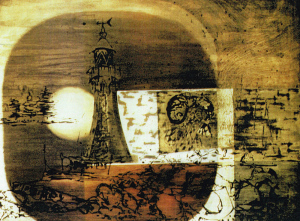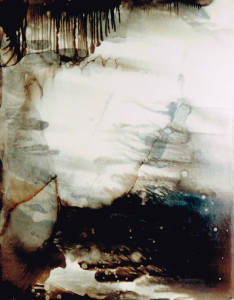Roberta Howland (now Bell-Allen), whose work is presented under her maiden name, Roberta Bell, is an artist able to bring a secret inner landscape to enhance all that her eye illuminates. The seemingly, randomly selected subjects of her paintings raise some topical questions.
- What are the sources of inspiration which feed an artist with ideas?
- To what extent can some of the ordinary slices of vision which continually move across the backs of our eyeballs, suddenly take imaginative hold and become fixed as the basis for a painting?
The idea that a painting required certain picturesque ingredients such as ruins, dense bushes in the lower corners, and a road running into the mountains where a white tree stands against a stormy sky, began to lose ground in the middle of the 19th century.
Yet, despite the fact that scientists have pretty well explained everything so that the essential innocence necessary for a romantic tradition is no longer present, there remain corners of the mind ready and willing to be stirred by mysteries, to quicken with interest at the inexplicable. Roberta Bell retains this ability to find wonder, and to notice marvels which hint at a magic world hovering in the background of ordinary things and ordinary places. She comes upon these subjects suddenly, as a trick of the light, or a strong response urges an immediate drawing.
This is an important step because visual impressions are fragile things which rapidly fade because what has to be remembered is not necessarily a structured image but a condition of an image. Thus a country road in the Pilliga Scrub, seen in moonlight through the rear of a car can make a poignant impact. A film by Chinese actors or snow seen for the first time in the mountains; the lighthouse in Wollongong harbour; some dancing girls displayed by a showground barker, can make a total impression.
The drawing is made right then and there as an objective statement.
And very beautiful drawings they are.
Drawings are the basis of all her paintings and this is where the discipline of long practice in draftsmanship and design is rewarded.
But while the quality of her drawings can be seen at a glance in the power generated in every line, these are only a means to an end: they are the starting points from which the completed painting can only be arrived at after a long probing search for the essence of mystery. Sometimes this is attained by revealing the subject through a series of veils, at other times the subject seems to be presented with the alternating clarity and obscurity of a dream.
This is the case in Through a Glass Darkly – a recent painting originating from seeing Wollongong lighthouse in gathering twilight. The stem off the lighthouse, inside a great circle of darkness, holds still as planes of light bear swiftly in with visions of sea and of life under the sea. Whatever literary or conceptual ideas set this picture going, its final emergence belongs entirely to the domain of art. Its visual impact is immediate, yet it continues to gain from sustained contemplation, as areas of beautifully surfaced paint take on depths beyond description.
Some five or six years ago amongst the paintings hung at the Bathurst Carillon City Festival Art Prize was a large, five or six feet high picture which intrigued me because it was obviously made by someone who knew what art was all about, yet it was too personal to fit into the mainstream style of that time. It was also eminently feminine in vision.
This was the first time I saw a Roberta Bell.
It consisted of big arc-like shapes in which mysterious lights gleamed. Generally it had an underwater character as though something enormous was being disclosed through some kind of unfamiliar medium, like perhaps it was seen through the window of a submarine. This idea was reinforced by the fact that the forms were made by scraping down through numerous fine layers of paint. In fact, instead of the painting being made by adding successive layers of colour to the picture surface, the reverse happened.
The paint was scraped away to uncover layers buried beneath layers inside the painting. The suggestion being that this was as far as one was permitted to see. The strange mystery of Roberta Bell’s paintings is not easily come by, and certainly does not reside in any technical hocus-pocus.
Roberta Bell was a five-year student at East Sydney, and was in fact an honours graduate. For years she taught drawing and design in the design school there. She has worked as a mural painter and has carried out design commissions.
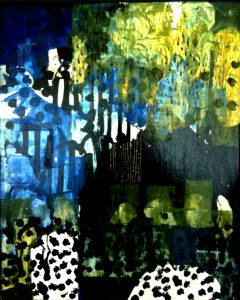 River Bank: The Darling 1960
River Bank: The Darling 1960
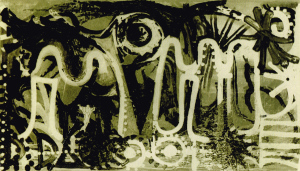
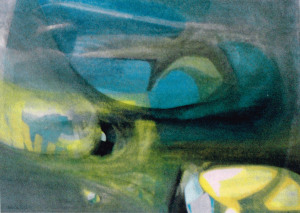
Country Fair Ground 1960 Storm 1994
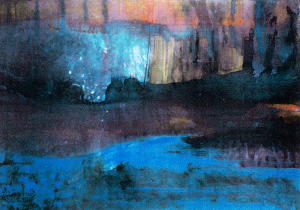
Sunset at Fitzroy Falls 1976
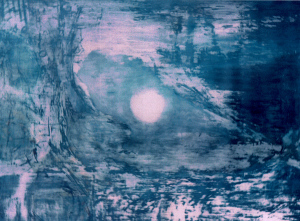
Night on the Pilliga Road 1963
